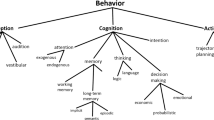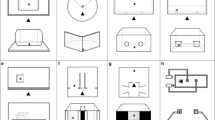Abstract
The ambiguity of the term ‘complex’ in studies of animal behaviour and cognition can lead to theoretical and methodological disputes, as there seems to be little common ground regarding the features thought to introduce complexity. Based on examples not only in human and nonhuman primates but also in some species of birds, we explore three dimensions of complexity: motor precision, coordination, and anticipatory planning. We argue that it is necessary to identify which dimensions are present in each study to formulate and explore relevant questions in behavioural sciences, especially with an evolutionary perspective.
Similar content being viewed by others
References
Annett M (1970) The classification of hand preference by association analysis. Brit J Psychol 61:303–321
Auersperg AMI, Szabo B, von Bayern AMP, Kacelnik A (2012) Spontaneous innovation of tool use and flexible manufacture in the Goffin’s cockatoo (Cacatua goffini). Curr Biol 22:903–904
Bellagamba F, Camaioni L, Colonnesi C (2006) Change in children’s understanding of others’ intentional actions. Dev Sci 9:182–188
Bird CD, Emery NJ (2009) Insightful problem solving and creative tool modification by captive nontool-using rooks. Proc Natl Acad Sci U S A 106:370–375
Boesch C, Head J, Robbins MM (2009) Complex tool sets for honey extraction among chimpanzees in Loango National Park, Gabon. J Hum Evol 56:560–569
Bullinger AF, Wyman E, Melis AP, Tomasello M (2011) Coordination of chimpanzees (Pan troglodytes) in a stag hunt game. Int J Primatol 32:1296–1310
Byrne RW (1998) The early evolution of creative thinking: evidence from monkeys and apes. In: Mithen S (ed) Creativity in human evolution and prehistory. Routledge, London, pp 110–124
Byrne RW, Bates LA (2010) Primate social cognition: uniquely primate, uniquely social, or just unique? Neuron 65:815–830
Byrne RW, Byrne JM (1993) The complex leaf-gathering skills of mountain gorillas (Gorilla g. beringei): variability and standardization. Am J Primatol 31:241–261
Byrne RW, Corp N, Byrne JM (2001) Manual dexterity in the gorilla: bimanual and digit role differentiation in a natural task. Anim Cogn 4:347–361
Byrne RW, Sanz CM, Morgan DB (2013) Chimpanzees plan their tool use. In: Sanz CM, Call J, Boesch C (eds) Tools use in animals: cognition and ecology. Cambridge University Press, Cambridge, pp 48–64
Connolly K, Dalgleish M (1989) The emergence of a tool-using skill in infancy. Dev Psychol 25:894–912
Dickinson A (2011) Goal-directed behaviour and future planning in animals. In: Menzel R, Fischer J (eds) Animal thinking: contemporary issues in comparative cognition. MIT Press, Cambridge, pp 79–91
Dufour V, Sterck EHM (2008) Chimpanzees fail to plan in an exchange task but succeed in a tool-using procedure. Behav Processes 79:19–27
Elgier AM, Jakovcevic A, Mustaca AE, Bentosela M (2012) Pointing following in dogs: are simple or complex cognitive mechanisms involved? Anim Cogn 15:11–19
Emery NJ, Clayton NS (2004) Comparing the complex cognitive abilities of birds and primates. In: Rogers LJ, Kaplan G (eds) Comparative vertebrate cognition: are primates superior to non-primates? Plenum, New York, pp 3–55
Fagard J, Marks A (2000) Unimanual and bimanual tasks and the assessment of handedness in toddlers. Dev Sci 3:137–147
Fitts PM (1954) The information capacity of the human motor system in controlling the amplitude of movement. J Exp Psychol 47:381–391
Fox PW, Hershberger SL, Bouchard TJ (1996) Genetic and environmental contributions to the acquisition of a motor skill. Nature 384:356–358
Friedman SL, Scholnick EK, Cocking RR (1987) Blueprints for thinking: the role of planning in cognitive development. Cambridge University Press, New York
Gergely G, Bekkering H, Király I (2002) Rational imitation in preverbal infants. Nature 415:755
Gerloff C, Corwell B, Chen R, Hallett M, Cohen LG (1998) The role of the human motor cortex in the control of complex and simple finger movement sequences. Brain 121:1695–1709
Goodall J (1986) The chimpanzees of Gombe: patterns of behavior. Belknap, Cambridge
Healy SD, Walsh P, Hansell M (2008) Nest building by birds. Curr Biol 18:271–273
Heyes CM (1998) Theory of mind in nonhuman primates. Behav Brain Sci 21:101–148
Holper L, Biallas M, Wolf M (2009) Task complexity relates to activation of cortical motor areas during uni- and bimanual performance: a functional NIRS study. Neuroimage 46:1105–1113
Hopkins WD, Russell J, Freeman H, Buehler N, Reynolds E, Schapiro SJ (2005) The distribution and development of handedness for manual gestures in captive chimpanzees (Pan troglodytes). Psychol Sci 16:487–493
Jarvis ED, Ribeiro S, da Silva ML, Ventura D, Vielliard J, Mello CV (2000) Behaviourally driven gene expression reveals song nuclei in hummingbird brain. Nature 406:628–632
Kacelnik A, Chappell J, Weir AAS, Kenward B (2006) Cognitive adaptations for tool-related behaviour in New Caledonian crows. In: Wasserman EA, Zentall TR (eds) Comparative cognition: experimental explorations of animal intelligence. Oxford University Press, Oxford, pp 515–528
Kaplan G (2011) Pointing gesture in a bird—merely instrumental or a cognitively complex behaviour? Curr Zool 57:453–467
Kawakami K, Kawakami F, Tomonaga M, Kishimoto T, Minami T, Takai-Kawakami K (2011) Origins of a theory of mind. Infant Behav Dev 34:264–269
Kenward B, Weir AAS, Rutz C, Kacelnik A (2005) Tool manufacture by naive juvenile crows. Nature 433:121
Liszkowski U, Carpenter M, Henning A, Striano T, Tomasello M (2004) Twelve-month-olds point to share attention and interest. Dev Sci 7:297–307
Luncz LV, Mundry R, Boesch C (2012) Evidence for cultural differences between neighboring chimpanzee communities. Curr Biol 22:1–5
Marino L (2002) Convergence of complex cognitive abilities in cetaceans and primates. Brain Behav Evol 59:21–32
Marino L, Connor RC, Fordyce RE, Herman LM, Hof PR, Lefebvre L, Lusseau D, McCowan B, Nimchinsky EA, Pack AA, Rendell L, Reidenberg JS, Reiss D, Uhen MD, Van der Gucht E, Whitehead H (2007) Cetaceans have complex brains for complex cognition. PLoS Biol 5:966–972
Mulcahy NJ, Call J (2006) Apes save tools for future use. Science 312:1038–1040
Napier JR (1956) The prehensile movements of the human hand. J Bone Joint Surg 38B:902–913
Ord TJ, Martins EP (2006) Tracing the origins of signal diversity in anole lizards: phylogenetic approaches to inferring the evolution of complex behaviour. Anim Behav 71:11–29
Osvath M (2009) Spontaneous planning for future stone throwing by a male chimpanzee. Curr Biol 19:R190–R191
Raby C, Clayton N (2009) Prospective cognition in animals. Behav Processes 80:314–324
Raby C, Alexis DM, Dickinson A, Clayton NS (2007) Planning for the future by western scrub-jays. Nature 445:919–921
Sambrook T, Whiten A (1997) On the nature of complexity in cognitive and behavioural science. Theor Psychol 7:191–213
Sanes JN, Donoghue JP (2000) Plasticity and primary motor cortex. Annu Rev Neurosci 23:393–415
Sanz C, Call J, Morgan D (2009) Design complexity in termite-fishing tools of chimpanzees (Pan troglodytes). Biol Lett 5:293–296
Seed A, Tomasello M (2010) Primate cognition. Topics Cogn Sci 2:407–419
Seed A, Emery N, Clayton N (2009) Intelligence in corvids and apes: a case of convergent evolution? Ethol 115:401–420
Steele J (1999) Paleoanthropology—stone legacy of skilled hands. Nature 399:24–25
Sugiyama Y (1997) Social tradition and the use of tool composites by wild chimpanzees. Evol Anthropol 6:23–27
Tanner JE, Byrne RW (2010) Triadic and collaborative play by gorillas in social games with objects. Anim Cogn 13:591–607
Tapley M, Bryden MP (1985) A group test for the assessment of performance between the hands. Neuropsychologia 23:215–221
Taylor AH, Elliffe D, Hunt GR, Gray RD (2010) Complex cognition and behavioural innovation in New Caledonian crows. Proc R Soc Lond [Biol] 277:2637–2643
Tebbich S, Bshary R (2004) Cognitive abilities related to tool use in the woodpecker finch, Cactospiza pallida. Anim Behav 67:689–697
Tumer EC, Brainard MS (2007) Performance variability enables adaptive plasticity of ‘crystallized’ adult birdsong. Nature 450:1240–1244
Vaesen K (2012) The cognitive bases of human tool use. Behav Brain Sci 35:203–218
Van Casteren A, Sellers WI, Thorpe SKS, Coward S, Crompton RH, Myatt JP, Ennos AR (2012) Nest-building orangutans demonstrate engineering know-how to produce safe, comfortable beds. Proc Natl Acad Sci U S A 109:6873–6877
Van Horik J, Clayton N, Emery N (2012) Convergent evolution of cognition in corvids, apes and other animals. In: Vonk J, Shackelford T (eds) Oxford handbook of comparative evolutionary psychology. Oxford University Press, New York, pp 80–101
Vasconcelos M, Hollis K, Nowahari E, Kacelnik A (2012) Pro-sociality without empathy. Biol Lett 8:910–912
Vauclair J, Meguerditchian A, Hopkins WD (2005) Hand preferences for unimanual and coordinated bimanual tasks in baboons (Papio anubis). Cogn Brain Res 25:210–216
Walsh PT, Hansell M, Borello WD, Healy SD (2010) Repeatability of nest morphology in African weaver birds. Biol Lett 6:149–151
Wimpenny JH, Weir AAS, Clayton L, Rutz C, Kacelnik A (2009) Cognitive processes associated with sequential tool use in New Caledonian crows. PLoS One 4:e6471
Acknowledgements
This work was supported by a postdoctoral research grant from the Fyssen foundation. The core idea of this article stems from discussions with the researchers attending the Tarragona Laterality Conference in February 2013.
Author information
Authors and Affiliations
Corresponding author
Rights and permissions
About this article
Cite this article
Cochet, H., Byrne, R.W. Complexity in animal behaviour: towards common ground. acta ethol 18, 237–241 (2015). https://doi.org/10.1007/s10211-014-0205-5
Received:
Revised:
Accepted:
Published:
Issue Date:
DOI: https://doi.org/10.1007/s10211-014-0205-5




